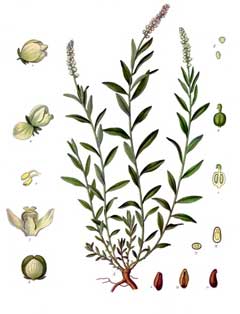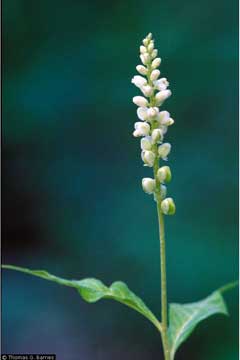 |
|
http://commons.wikimedia.org/wiki/File:Koeh-247.jpg |
 |
| Thomas G. Barnes @ USDA-NRCS PLANTS Database / Barnes, T.G., and S.W. Francis. 2004. Wildflowers and ferns of Kentucky. University Press of Kentucky. |
Translate this page:
Summary
Physical Characteristics

 Polygala senega is a PERENNIAL growing to 0.3 m (1ft) by 0.3 m (1ft in).
Polygala senega is a PERENNIAL growing to 0.3 m (1ft) by 0.3 m (1ft in).
See above for USDA hardiness. It is hardy to UK zone 2. It is in flower in June. The species is hermaphrodite (has both male and female organs).
Suitable for: light (sandy), medium (loamy) and heavy (clay) soils and prefers well-drained soil. Suitable pH: mildly acid, neutral and basic (mildly alkaline) soils and can grow in very alkaline soils.
It can grow in semi-shade (light woodland) or no shade. It prefers dry or moist soil.
UK Hardiness Map
US Hardiness Map
Synonyms
Polygala albida. Senega officinalis.
Plant Habitats
Woodland Garden Sunny Edge; Cultivated Beds;
Edible Uses
References More on Edible Uses
Medicinal Uses
Plants For A Future can not take any responsibility for any adverse effects from the use of plants. Always seek advice from a professional before using a plant medicinally.
Abortifacient Antidote Cathartic Diaphoretic Diuretic Emetic Expectorant Sialagogue
Stimulant
Seneca snake root was employed medicinally by several native North American Indian tribes, who used it to treat a variety of complaints[257]. It is still used in modern herbalism where it is valued mainly as an expectorant and stimulant to treat bronchial asthma, chronic bronchitis and whooping cough[254].The root contains triterpenoid saponins, these promote the clearing of phlegm from the bronchial tubes. The root is antidote, cathartic, diaphoretic, diuretic, emetic, expectorant, sialagogue, stimulant[4, 21, 46, 165, 222, 238]. It was used by the North American Indians in the treatment of snake bites[4, 46] and has been found of use in the treatment of various respiratory problems including pleurisy and pneumonia[4, 257]. The root is harvested when the plant dies down in autumn and is dried for later use[4]. Use with caution[4, 21], excess doses cause diarrhoea and vomiting[238]. See also the notes above on toxicity. A tea made from the bark has been drunk in order to bring about a miscarriage[213]. The dried root is used as a stimulating expectorant - it is said to owe its medicinal value to the presence of saponins and in large doses is poisonous[213]. The root is harvested in the autumn[213]. The root has been used to treat snakebites, it is chewed and applied to the bite[213]. The German Commission E Monographs, a therapeutic guide to herbal medicine, approve Polygala senega for cough/bronchitis (see [302] for critics of commission E).
References More on Medicinal Uses
The Bookshop: Edible Plant Books
Our Latest books on Perennial Plants For Food Forests and Permaculture Gardens in paperback or digital formats.

Edible Tropical Plants
Food Forest Plants for Hotter Conditions: 250+ Plants For Tropical Food Forests & Permaculture Gardens.
More

Edible Temperate Plants
Plants for Your Food Forest: 500 Plants for Temperate Food Forests & Permaculture Gardens.
More

More Books
PFAF have eight books available in paperback and digital formats. Browse the shop for more information.
Shop Now
Other Uses
References More on Other Uses
Cultivation details
Prefers a moderately fertile moisture-retentive well-drained soil, succeeding in full sun if the soil remains moist throughout the growing season, otherwise it is best in semi-shade[200]. Dislikes shade according to another report. The sub-species P. senega latifolia. Torr.&Gray. is cultivated as a medicinal plant in Japan[174].
References Carbon Farming Information and Carbon Sequestration Information
Temperature Converter
Type a value in the Celsius field to convert the value to Fahrenheit:
Fahrenheit:
The PFAF Bookshop
Plants For A Future have a number of books available in paperback and digital form. Book titles include Edible Plants, Edible Perennials, Edible Trees,Edible Shrubs, Woodland Gardening, and Temperate Food Forest Plants. Our new book is Food Forest Plants For Hotter Conditions (Tropical and Sub-Tropical).
Shop Now
Plant Propagation
Seed - sow spring or autumn in a cold frame[214]. When they are large enough to handle, prick the seedlings out into individual pots and grow them on in the greenhouse for their first winter. Plant them out into their permanent positions in late spring or early summer, after the last expected frosts. Division. Cuttings of young shoots in a frame in late spring[1].
Other Names
If available other names are mentioned here
Native Range
NORTHERN AMERICA: Canada (Québec, Ontario, New Brunswick, Saskatchewan, Alberta, Manitoba, British Columbia), United States (Connecticut (west), Indiana, Maine (north), Massachusetts (west), Michigan, New Jersey, New York, Ohio, Pennsylvania, Vermont, West Virginia, Illinois, Iowa, Kansas, Missouri, Nebraska, North Dakota, Oklahoma, South Dakota, Wisconsin, Colorado, Arkansas, Delaware, Georgia, Kentucky, Maryland, North Carolina, South Carolina, Tennessee, Virginia)
Weed Potential
Right plant wrong place. We are currently updating this section.
Please note that a plant may be invasive in one area but may not in your area so it's worth checking.
Conservation Status
IUCN Red List of Threatened Plants Status :

Growth: S = slow M = medium F = fast. Soil: L = light (sandy) M = medium H = heavy (clay). pH: A = acid N = neutral B = basic (alkaline). Shade: F = full shade S = semi-shade N = no shade. Moisture: D = dry M = Moist We = wet Wa = water.
Now available:
Food Forest Plants for Mediterranean Conditions
350+ Perennial Plants For Mediterranean and Drier Food Forests and Permaculture Gardens.
[Paperback and eBook]
This is the third in Plants For A Future's series of plant guides for food forests tailored to
specific climate zones. Following volumes on temperate and tropical ecosystems, this book focuses
on species suited to Mediterranean conditions—regions with hot, dry summers and cool, wet winters,
often facing the added challenge of climate change.
Read More
Expert comment
Author
L.
Botanical References
43200235
Links / References
For a list of references used on this page please go here
Readers comment